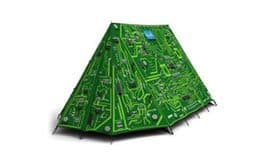Most Commonly Used Terms

To assist in understanding printed circuit boards, Avanti Circuits has put a list of some of the most commonly used terms in PCB manufacturing. For a more detailed glossary of PCB terms, visit Avanti Circuits’ PCB glossary.
Anti-Tarnish – A post-dip chemical process used to retard oxidation of copper circuits.
Backup Material – Hard flat material used to back-up laminate when drilling to reduce burrs.
Backplane – A very thick, large circuit board used to hold an array of pins for wire wrapping.
Blanking Die – Using a die punch to “blank out” the finished circuit board, used mostly for single-sided panels.
Blow Holes – Blow holes caused by an outburst of gas from solder fillet on a circuit board during the soldering operation.
C-Stage – Fully-cured dielectric laminate.
Caul Plates – Rigid, polished, flat, stable steel plates used when pressing or laminating MLBs
Clad – A condition of the base material to which a relatively thin layer or a sheet of metal foil has been bonded to one or both of its sides.
Conversion Coating – Anti-oxidant treatment applied to raw vendor foil.
DES – Develop, etch & strip process used in the etching stage of inner-layer fabrication.
Direct Plate – Application of conductive coatings on drilled holes to provide electrical continuity for electrolytic plating.
DOE – Design of experiments… a formal method of designing an interactive test matrix.
Dog Bone – A plating defect found in drilled holes where the electroplated copper is thin in the center and thicker at the knee.
Double Treat – Brass-based coating applied to copper foil as a substitute for oxide.
Entry Material – Thin metal foil (usually aluminum) attached to top side of drill stack to reduce drilling burrs and cool drill.
FPPY – First pass panel yield… number of good “panels” after subtracting defective panels.
Flux – A chemical activator use when reflowing solder or attaching components.
Haloing – Fracturing/delamination on or below the surface of the base material; it is usually exhibited by a light area around holes.
Hard Board – Rigid circuit board.
Liquid Resist – The liquid form of photoresist used in the fabrication of circuits.
Mil Spec – Specification set forth by the military.
Mil – Common term used to define thicknesses below 0.100 inches. (One mil = 0.001 inches).
Millionths – Term used when defining thickness. (100 millionths = 0.0001 inches.)
Mother Board – A printed circuit board used for interconnecting arrays of plug-in electronic modules.
Nail Heading – The flared condition of copper on the innerconnect layer of a multilayer caused by poor drilling.
One Ounce Foil – Weight of 1 square foot of copper foil. (1 oz = 0.00134 inches, ½ oz = 0.0007 inches, etc.)
OSHA – Occupational Safety & Health Agency.
OSP – Organic Surface Protection.
Oxide – A special treatment applied to copper surfaces of inner layers of a PWB to insure bond integrity.
Panel – Used to describe a common sheet size used in the fabrication process, ie: 24” X 18”.
Panel ft (Laminate ft) – A laminate area measurement, one-side only of the panel. (1 panel, 18” X 24” X 1 side = 3 panel ft).
Pattern-Plate – Electroplating of circuits using photoresist as a mask to protect the background, usually copper & tin.
Photoresist – An organic emulsion containing photoactive compounds, which will crosslink when exposed to UV light.
Pin Holes – Small defects etched through a circuit pattern.
Pink Ring – A defect caused by poor bonding around drilled holes displayed by acid attack of the oxide.
Pitch (density) – A method of defining circuit lines and spaces i.e.; 4 & 4, 4 mil lines and 4 mil spaces.
Plasma – Creation of corona in a chamber by exciting certain gasses in a partial vacuum with an electrical field, used to desmear.
Power Plane – Heavy circuit features designed to carry high electrical loads in a PWB.
Print – Expose step to define circuit patterns in photo resist.
Print & Etch – Simple fabrication method using photoresist to define etch pattern.
Pumice Scrub – A mechanical cleaning step using brushes and an abrasive media.
Punching – Using dies to punch component holes, usually in single & double-sided PWBs.
Signal Layer – Fine circuits designed to carry high speed signals throughout a circuit board and its components.
Skip Plate – Area of absent metal in plating.
Solder Plate – Tin/lead alloy plated in a pattern to define the finished features or circuits.
SPC – Statistical Process Control.
Surface ft – Total surface square feet area of a given work piece. (1 panel 18” X 24” X 2 sides = 6 surface ft).
Tab Plate – Selective plating on edge connectors, usually nickel/gold.
Tabs – A portion of a conductive pattern formed by printing, serving as one part of a contact system.
Tenting – A printed circuit board fabrication method of capping plated-through holes and the surrounding conductive pattern with a dry film resist.
Thin Core – Thin laminate, usually less than 0.005 inches thick.
Wedge voids – A layer separation defect in a drilled hole which are sites for retention of process chemicals.